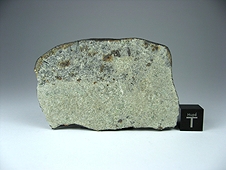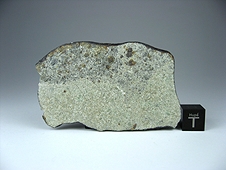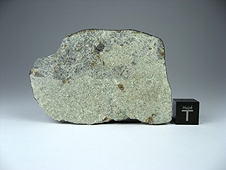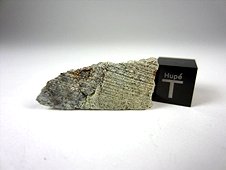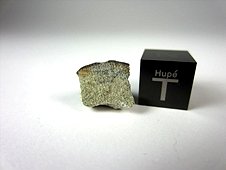NWA 7030 Anomalous Sanidine-rich LL Metachondritic Breccia Meteorite
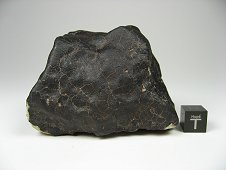
NWA 7030 has been under intense analysis since November 2011. The classification is still not complete as more in depth measurements are being conducted. So far, it is a new Ungrouped meteorite with some very interesting characteristics!
Based on study of a large thin section of this unusual specimen, the main portion appears to be an LL metachondrite completely lacking chondrules and composed of olivine, clinopyroxene, sodic plagioclase, chromite, troilite and taenite. Oxygen isotopes determined by Dr. Ryoji Tanaka by laser fluorination at Okayama University δ17O = 4.414, 4.357; δ18O = 6.235, 6.059; Δ17O = 1.129, 1.164 per mil) plot within the field for LL chondrites. A subordinate green, igneous-textured lithology (which was the one first examined in sample RC18.1) contains much less troilite, and consists of olivine(Fa29.1), clinopyroxene (Fs12.6Wo), orthopyroxene(Fs23.6Wo3.7), chromite, taenite, rare kamacite, sanidine (Or88.2-91.2Ab7.4-5.3An4.4-3.5) and sodic plagioclase (both as separate grains and as exsolved lamellar pairs in single grains).
The oxygen isotope data establish an affinity with LL chondrites, but the exact relationship of this specimen to the LL chondrite parent body is unclear. Detailed work continues. NWA 7030 has been under intense analysis since November 2011, but the classification is still not complete and more in-depth measurements are being conducted.
Here are some comments from the lead scientist, Dr. Tony Irving (11-18-2011):
"NWA 7030 is one-of-kind. I have attached a back-scattered electron image we took, partly because Ryoji Tanaka was so eager to see what it was like (see link below). Olivine (light gray) is the most abundant mineral, then orthopyroxene (slightly darker gray), then interstitial potassium feldspar (dark gray); the small bright grains are mostly taenite and some that are lighter gray are chromite and troilite. The overall texture is that of a fine grained igneous cumulate rock..
As far as I know there is no other meteorite containing a lithology that is this potassic. Scientists at ETH-Zurich are measuring the noble gases for a CRE age, and other scientists are conducting Ar-Ar isotopic analyses, both of which will be reported soon. The other interesting thing about this achondrite is that its formation age can be determined easily using argon-argon isotopes, since argon-40 is the product of decay of potassium-40. As I mentioned, in addition to getting oxygen isotopes at Okayama University, I have written to the scientists in Zurich to ask whether they would measure noble gases for a CRE age.
Exciting stuff."
"This is a highly unusual achondrite composed of olivine, orthopyroxene with interstitial potassium feldspar (yes, really!), taenite, kamacite, troilite and chromite. Definitely not a eucrite, brachinite, lunar or Martian".
Back-scattered electron image of NWA 7030:
Click here to view the back-scattered electron image of NWA 7030
Lab analysis at the University of Central Florida:
Click here to see some iimages of NWA 7030 on my Expeditions & Adventures page.
I have pre-sold some of this material, the majority of which is in the 120 gram main mass that is curated in a private collection. I have listed all that is available here!
Based on study of a large thin section of this unusual specimen, the main portion appears to be an LL metachondrite completely lacking chondrules and composed of olivine, clinopyroxene, sodic plagioclase, chromite, troilite and taenite. Oxygen isotopes determined by Dr. Ryoji Tanaka by laser fluorination at Okayama University δ17O = 4.414, 4.357; δ18O = 6.235, 6.059; Δ17O = 1.129, 1.164 per mil) plot within the field for LL chondrites. A subordinate green, igneous-textured lithology (which was the one first examined in sample RC18.1) contains much less troilite, and consists of olivine(Fa29.1), clinopyroxene (Fs12.6Wo
The oxygen isotope data establish an affinity with LL chondrites, but the exact relationship of this specimen to the LL chondrite parent body is unclear. Detailed work continues. NWA 7030 has been under intense analysis since November 2011, but the classification is still not complete and more in-depth measurements are being conducted.
Here are some comments from the lead scientist, Dr. Tony Irving (11-18-2011):
"NWA 7030 is one-of-kind. I have attached a back-scattered electron image we took, partly because Ryoji Tanaka was so eager to see what it was like (see link below). Olivine (light gray) is the most abundant mineral, then orthopyroxene (slightly darker gray), then interstitial potassium feldspar (dark gray); the small bright grains are mostly taenite and some that are lighter gray are chromite and troilite. The overall texture is that of a fine grained igneous cumulate rock..
As far as I know there is no other meteorite containing a lithology that is this potassic. Scientists at ETH-Zurich are measuring the noble gases for a CRE age, and other scientists are conducting Ar-Ar isotopic analyses, both of which will be reported soon. The other interesting thing about this achondrite is that its formation age can be determined easily using argon-argon isotopes, since argon-40 is the product of decay of potassium-40. As I mentioned, in addition to getting oxygen isotopes at Okayama University, I have written to the scientists in Zurich to ask whether they would measure noble gases for a CRE age.
Exciting stuff."
"This is a highly unusual achondrite composed of olivine, orthopyroxene with interstitial potassium feldspar (yes, really!), taenite, kamacite, troilite and chromite. Definitely not a eucrite, brachinite, lunar or Martian".
Back-scattered electron image of NWA 7030:
Click here to view the back-scattered electron image of NWA 7030
Lab analysis at the University of Central Florida:
Click here to see some iimages of NWA 7030 on my Expeditions & Adventures page.
I have pre-sold some of this material, the majority of which is in the 120 gram main mass that is curated in a private collection. I have listed all that is available here!
Copyright 2012 - Current All Rights Reserved Nature's Vault, Inc.



